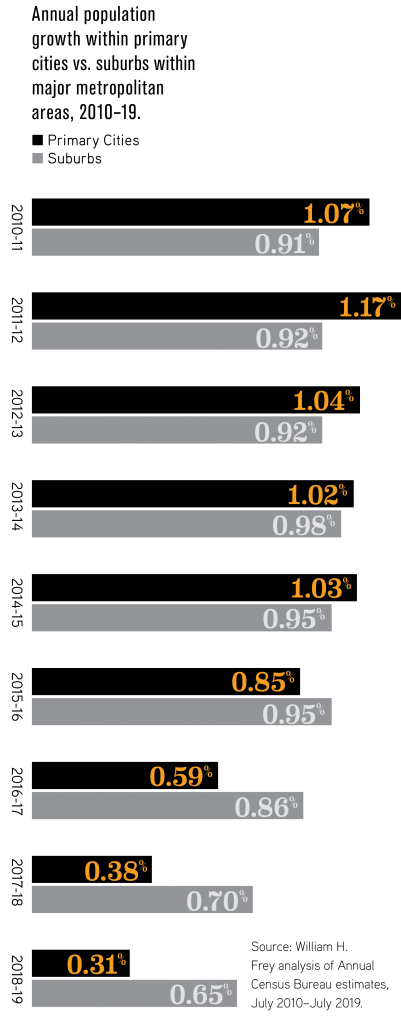Housing priorities are shifting due to COVID-19
By Kathleen Hagan
In the early 2010s, many cities across the U.S. experienced growth as the economy began to recover from the Great Recession.
Marketing to What Buyers Want
During this time of urban exodus, buyers are looking for:
- More indoor square footage
- A dedicated home office
- A bonus room
- Large lots
- Outdoor space (yard, patio, deck, balcony, etc.)
- Privacy
- Peace and quiet
- Easy access to nature (parks, trails, green space)
- Vacation homes
Adding these keywords to your marketing or advertising materials can let buyers know that a property has these highly sought-after amenities, or that you are ready to help them find a new home that can check off these boxes.
Major corporations moved their suburban offices to downtown areas, and much was written about how millennials, now the largest living adult generation in the country, preferred an urban lifestyle.
As recently as late last year, cities were best known for their vibrant cultures, robust arts-and-entertainment districts, one-of-a-kind restaurants and shops, and walkability. But as the new coronavirus began to spread in early 2020, city life became synonymous with high COVID-19 case counts, cramped quarters and shuttered businesses.
As a result, housing priorities have shifted among buyers and renters alike. Many real estate markets across the country have seen an uptick in city dwellers—across all demographics, but with millennials who have young families in particular—ditching their high-rise apartments, cramped condos and tiny lots for more spacious homes in the suburbs, or even significant amounts of land in more rural areas.
It’s not just more space that is appealing to urbanites old and young. As REALTORS® across the country can attest, there are a number of reasons why people are choosing to leave life in the big city behind. Suburban and rural living offer myriad benefits that have become more important during this time of continued change.

The affordability factor
Americans who have been laid off or furloughed in recent months may find they can no longer afford their monthly mortgage or rent payment in a city, forcing them to find a less-expensive place to call home. For some, this could mean a move to a nearby suburb, where real estate and property taxes are typically less expensive.
In the country’s largest metro areas like New York, San Francisco, Los Angeles and Chicago, this shift has already been happening. Michele Chiles-Hickman, CRS, with Berkshire Hathaway HomeServices New Jersey Properties in Montclair,
New Jersey, first noticed more buyers and renters looking to move out of New York City about five years ago. The reason was straightforward: The cost of living was getting too high.
“After the 2008–2009 financial crisis, as the market started to rebound more, it became less affordable for people to live in the city,” explains Chiles-Hickman, whose firm is located just 13 miles outside of Manhattan. “People began moving to the suburbs due to the lower cost of living, and they also saw other benefits like more space, lower noise levels, more privacy, better parks and green space, and, in some cases, better-rated schools.”
Kevin Burgess, CRS, broker/owner of Values Driven Realty Inc. in Plainfield, Indiana, notes that in his market just outside of Indianapolis, most people typically have stayed closer to town because of easy access to city amenities. But that is changing. “There are homes in rural areas that qualify for a USDA-backed loan that allow a buyer to purchase a home with some acreage for very little money—but the agent must also make sure the buyer qualifies for the USDA loan type,” he says.
Greener Pastures
Within the last five years or so, Sherry Anderson, CRS, independent broker/owner in Colorado Springs, Colorado, has noticed a trend—especially among younger buyers—of people wanting to be more self-sufficient. “People are looking for properties where they can raise chickens and grow their own food,” she says.
REALTOR® Magazine reports that Google searches for backyard coops to raise chickens has increased since the beginning of the COVID-19 pandemic. Homeowners want better access to fresh eggs at a time when visiting the grocery store has become riskier.
Kevin Burgess, CRS, broker/owner of Values Driven Realty Inc. in Plainfield, Indiana, is seeing this trend play out in his market as well. “People want to have animals and be more self-reliant,” he says. “A homeowners’ association can hinder that, so people are moving out of neighborhoods where there are covenants and rules and into more rural areas.” Both Anderson and Burgess have helped buyers find homes on “hobby farms,” where food production is intended for recreation and self-sustaining purposes rather than for income. “People have romanticized the idea of living in the country,” Anderson says. “But it really makes sense. You’re able to provide for yourself and you don’t have to be as dependent on the grocery store—which is becoming especially important during our current times.”
However, while the benefits of being able to grow your own food and raise chickens are great, Burgess notes there are some drawbacks to rural life. “Depending on how far out you go, you might not be able to get high-speed internet, reliable cell service or other modern conveniences,” he says. “You also should consider that there are fewer contractors you can hire to help when your HVAC system goes out, for instance.”
The Non-Factor
When buying a home, assessing the commute to work traditionally has been an important factor for many buyers. And for good reason: Studies show that people who have commute times of less than 30 minutes have higher levels of happiness. But as telecommuting has become more normalized during the COVID-19 pandemic, some buyers are no longer making their commute a priority.
Michele Chiles-Hickman, CRS, with Berkshire Hathaway HomeServices New Jersey Properties in Montclair, New Jersey, says clients used to ask about a home’s proximity to the train that would take them into New York City. Now, “not everyone is coming to town saying, ‘I need to see where the train is,’” she says. “I’ve also seen more properties being sold in towns that aren’t your typical commuter towns.”
Kevin Burgess, CRS, broker/owner of Values Driven Realty Inc. in Plainfield, Indiana, also notes that he has had buyers who simply are willing to sacrifice their commute time for the freedom that living in the country allows. “But if people are going to be working from home now,” he adds, “that’s not as much of a problem.”
Spaced out
As Burgess notes, proximity to the action is a big draw of urban life. Many amenities—grocery stores, retail stores, restaurants, bars, fitness centers, public transit—are located right outside the door or within walking distance. “Being close to certain amenities is still important, but it’s not as much of a priority at the moment for my clients,” says Chiles-Hickman. “The amount of time people have been spending at home [due to COVID-19] is making them reevaluate the kind of space they want, and they can’t get that kind of space in the city.”
Widespread telecommuting and remote learning have increased homeowners’ desire for more square footage and a dedicated office space in their home. “I have a client who is upgrading within his current [suburban] community and moving into a bigger rental,” says Peter Cagnassola, CRS, broker/owner of Bedminster Hills Realty Inc. in Pluckemin, New Jersey, about 35 miles west of Manhattan. “He doesn’t expect to go back to work at his office in Manhattan anytime soon, so he wants to have room to set up a home office. He also needs more space for his college-aged daughter to come back and live with him for a while.”
Cagnassola also speculates that people might be looking for different floor plans. The open concept, which has been popular in recent years, is not very practical when multiple family members have video calls scheduled at the same time. A closed floor plan can offer separate rooms for each family member to escape to find peace and quiet.
As health care professionals stress that the risk of contracting COVID-19 is significantly lower when outdoors, having a private yard, outdoor patio or deck to host gatherings where attendees can practice social distancing is becoming a bigger priority among buyers as well. “I have been seeing urbanites seeking to move to housing that affords outdoor spaces,” says Amy Schultz, CRS, with Ebby’s Little White House in Dallas, Texas.
For young families, having a backyard and space for kids to run around and play is paramount when parks are closed or access to them is limited. For pet owners, having a fenced-in yard is also important. “If you have a nice-sized lot and install good-quality perimeter dog fencing, the property becomes more sellable because of all the buyers these days who want their dogs to have room to run,” says Sherry Anderson, CRS, independent broker/owner in Colorado Springs, Colorado. “I think the trend is not only for people looking to live more healthy and sustainable lives themselves; they want the same for their pets.”
Anderson adds that in addition to more space, her clients also appreciate that suburban and rural properties are much quieter and more peaceful. “They really enjoy being away from all of the hustle and bustle of the city,” she says.
Making Moves
As more and more people look to move out of downtown areas, CRSs can make calculated moves to capitalize on the urban exodus trend. They also have a unique opportunity to create win-win opportunities by educating themselves on what’s at the core of the desire to move to the country or move to the suburbs. Here are three steps CRSs can take to get a leg up:
Network with other real estate agents. Some city dwellers may contact the REALTOR® who helped them find their downtown condo and ask if they know anyone who can help them find their dream home in the suburbs. Building and having strong relationships with urban REALTORS® can help suburban CRSs get referrals and leads when urbanites decide to move out. Likewise, urban REALTORS® can benefit from a referral when there are not as many buyers moving in. “I was invited, and joined as a guest, a Business Network International group for the city [Manhattan],” says Michele Chiles-Hickman, CRS. “It’s a chance to get in front of agents from that area who can send leads.”
Highlight your listings’ best assets. “It’s always important to know who your buyer is and to be able to see through the buyer’s eyes,” says Sherry Anderson, CRS. “This must translate into the photos, verbiage and marketing.”
Anderson always uses a professional home stager and photographer for her listings, and she makes sure she’s onsite when photographs are taken. “It’s my job, as the listing agent and expert in this particular niche, to tell the photographer what is important to show in photos as selling points,” she says.
In particular, Anderson makes sure her listing photos show off:
- The yard
- The house from a distance (to show the space around it)
- Trees
- Any outbuildings, including chicken houses, inside and out
- Outdoor play areas for children
- Outdoor entertaining spaces
- Fruit trees and gardens, including any photos from the owner that show the fruits and veggies
- Nearby parks, ponds, lakes, hiking areas and open spaces
Show that you’re still in business—and being safe and smart about it. “I have been purposeful during COVID-19 to add several Instagram and LinkedIn posts showing we are open and how we are doing business,” Chiles-Hickman says. “People need to know we are working because they want to move now!” Buyers and sellers alike want to know that you’re taking precautions. Being transparent—and vocal—about the steps you’re taking to ensure the safety and well-being of all involved can help people feel more comfortable working with you.
Accelerated timelines and shifting priorities
While many buyers and renters have been looking to escape city life for at least a few years, Chiles-Hickman has noticed that COVID-19 is speeding up the timeline in her market. “Families that were considering a move in the fall pushed up their timeline to the summer. People who were on the fence about moving are getting off the fence. The [population] density of New York City makes it very hard to live there during the COVID-19 pandemic,” she says.
And based on the phone calls she’s been having with potential clients, Chiles-Hickman expects this urban exodus trend to continue and pick up even more. “Moving is a big decision to make,” she says. “Even if you’re scared [about getting sick from the coronavirus], you can’t just decide to move in two weeks’ time—there is a lag with all real estate.”
“I think it’s going to be a new world when this is all said and done,” adds Cagnassola. “COVID-19 is going to have a huge impact on how people satisfy their housing needs moving forward.”
Building Partnerships
As buyers move away from the city, Kevin Burgess, CRS, broker/owner of Values Driven Realty Inc. in Plainfield, Indiana, is seeing more of a demand for new construction in the suburbs. In his market just outside of Indianapolis, existing home inventory is tight, land value is rising and builders can’t keep up with the demand for new homes.
In light of this trend, Burgess and his agents are seizing the opportunity to help buyers work with builders to purchase properties in brand-new neighborhoods. “I think there’s an opportunity right now for REALTORS® to work with builders and buyers,” he says. “Most sales reps for the builder appreciate a professional real estate agent because it makes their job a little easier.”
For buyers, it’s about making them aware of the value of using a REALTOR® to help navigate the process of purchasing new construction. “I don’t think enough buyers understand we can help them, and that it doesn’t cost them any extra to work with a real estate broker because it’s already built into the marketing cost for the builder,” Burgess explains.
Meet your Designation Maintenance requirements today! Read this article and “In the Weeds,” take a 10-question quiz and earn 2 credits. Go to CRS.com/trs-quiz to get started.
To learn more about current real estate market trends, visit realtor.com/research.
Photo: iStock.com/Cemile Bingol/Amanda Goehlert








